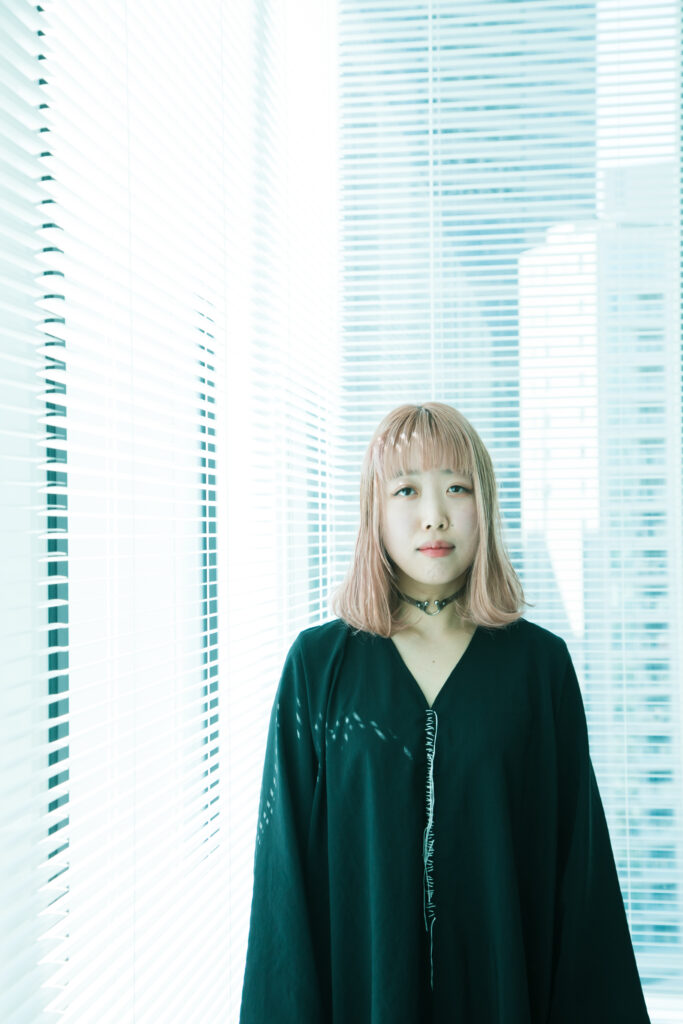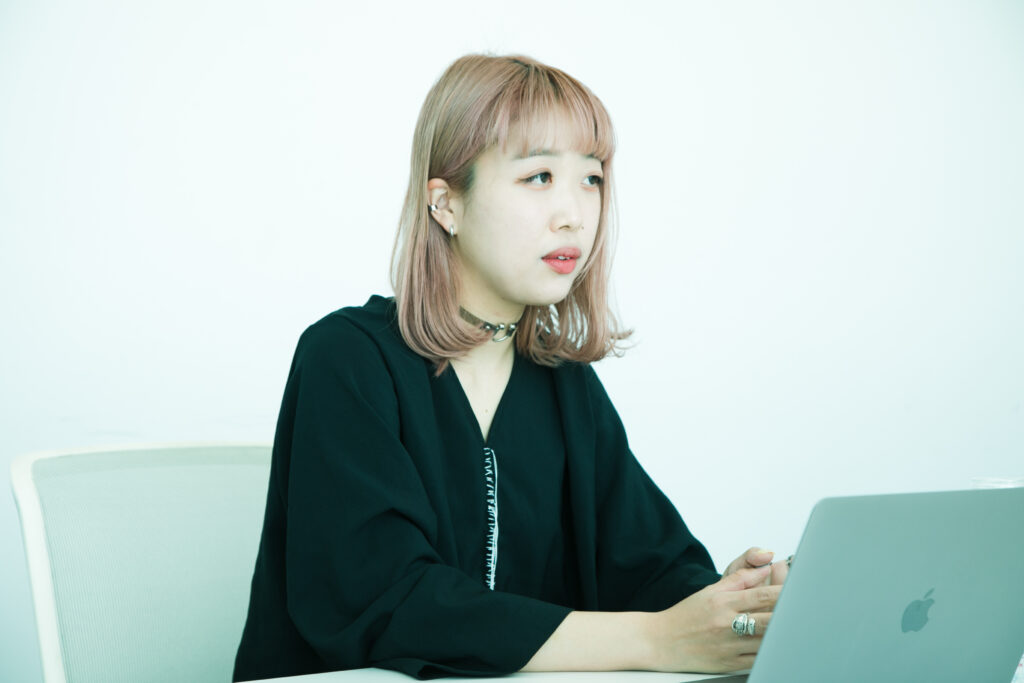In 2020, artists who still hadn’t made their CD debut appeared on Kōhaku Uta Gassen, a New Year’s Eve singing show. The music video for “Usseewa” by Ado amassed over a hundred million views on YouTube in less than five months, and it was number one on Billboard Japan Hot 100, despite the physical album not being released yet. Evidently, what makes a hit song has been changing at a rapid pace from last year. The process, influences, and the type of songs that become hits have been changing too. In any era, the pop culture craze begins with teenagers; analyzing their psychology and consumer habits helps us understand what songs will become hits in the future. Yuki Taniguchi, a member of Hakuhodo’s content business lab, researches how people consume entertainment and examines hit songs. We asked her about what sort of results she’s seen in her data and research.
From listening to music to using it
——In your view, how has the way music is transmitted today, via streaming services, changed since the CD era?
Yuki Taniguchi: I think three things changed since we transitioned from CDs to streaming songs. First, the indicator of a hit song changed from the number of CD copies sold to the number of streams a song gets. The hit song formula changed to the number of active listeners multiplied by the number of plays. Second, because people mix old songs and new songs in the same playlist, the idea of old versus new is disappearing. Third, because of the new format of playlists, more artists want to gain more listeners using playlists. There’s even a term for it: playlist marketing. I feel like as a listener, we now live in an age where we come across [music] in an unprecedented way.
——What factors affect the increase of “the number of active listeners” and “the number of plays”?
Taniguchi: The increase of listeners is determined by how many playlists on different streaming services an artist is on. Also, the number of times a song is played on YouTube, TikTok, and other social media platforms has a role. Those are important points. Today, song covers, tweets, and user-generated content (UGC) are paramount. For instance, when YOASOBI started gaining popularity, users would say, “This is based on a novel.” That was fresh, and it made them want to share it with others. Users’ desire to share a song with others on social media leads to it spreading. Calculating that is very difficult, and those in the music industry say, “Half of the equation is luck” (laughs). That determines whether an artist’s song spreads.
The strength of UGC lies in how regular users could relate to, be familiar with, and feel like copying content precisely because other regular users post said content. That’s why songs go viral on TikTok before streaming services as of recently. On Tiktok, it’s easy for people to feel like, “If that person’s listening to that song, I’ll try listening to it too. If that person’s using that song, I’ll try using it too.” One characteristic of TikTok is how users “use” songs, not “listen” to them; the verb is already shifting here.
Another way to increase the number of streams per listener is to make an addicting song, even though it’s an abstract thing to say. Ado’s “Usseewa” and YOASOBI’s songs are addicting, which is why people are talking about them. As a listener, I don’t know how to make a song that’s addicting, but I hope to design something like that.
——Although luck is a part of the equation to gain more listeners, do you think it’s possible to manufacture that a bit?
Taniguchi: Artists need to get listeners to like them for other aspects, not just music. For example, there are cases like Doul gaining fans from abroad overnight because a famous artist overseas shared their work or followed them. However, Doul is involved in creating her music videos, does her makeup and styles herself, and speaks English; she’s established her own cool Doul world. I think she has the aim to get people hooked on her worldbuilding, not just her songs. For artists, their music is one aspect of who they are, but they must develop more attributes, such as fashion and makeup, to build their own world and reel people in. Contrarily, by not showing their faces, those who make Vocaloid music create a mystery about them and successfully establish their universe.
——Do you think THE FIRST TAKE (a YouTube channel that shoots videos of artists performing in one take) has influence, like playlists and UGC, which you mentioned are influential?
Taniguchi: It has quite a lot of influence. Data shows that whenever a video from THE FIRST TAKE is released, the number of plays on streaming services and social media posts goes up. Because they’re up to date with [music] trends, it’s easy for their content to become topical like, “So-and-so was on THE FIRST TAKE yesterday.” One member from the content business lab and I chatted about how THE FIRST TAKE feels like a live show. Perhaps this channel gained this much acclaim because their videos have replaced live performances during the pandemic.
What matters are preferences and trends, rather than genres
——What other services are popular with teenagers right now?
Taniguchi: Compared to other ages, the rate of teenagers who use Line Music is high. The user rate among teenage girls, 18%, is notably high (even with Apple Music and Spotify, which have comparably high user rates in Japan, the overall usage rate is 6%). The music charts on Line Music and other streaming services are quite different, which is interesting. The top songs on Line Music’s charts show up on the Apple Music charts afterward. If you want to know what kind of music is trendy among young people, look at Line Music’s charts.
The trend among teenage boys is listening to the radio more than before. They watch/listen to YouTube while doing other things, so it’s pretty similar to the radio. YouTube and the radio are virtually the same for them. For instance, I believe those who like Shimofuri Myojo (a Japanese comedy do) consume Shimofuritube, their YouTube channel, and Shimofuri Myojo no All Night Nippon 0, their podcast, in a similar manner. Streaming services include podcasts, so perhaps the line between audio content and music content is barely there.
——What sort of genre do young people like today, according to data?
Taniguchi: According to a survey SHIBUYA109 lab. (SHIBUYA109 lab. Trend Forecast 2021, a survey targeted at 15 to 24-year-old girls/women) released the other day, sentimental hip hop was among the popular ones in their artists’ category. Social media users like using songs by artists who embody their emotions, like Takaya Kawasaki and Yuri. Plus, hip hop is trendy, so I assume that’s why sentimental hip hop is popular.
There’s the view that genres don’t matter anymore. King Gnu makes a blend of rock and other genres, and K-pop is a mix of western music and J-pop. There are so many songs with different elements that it’s impossible to say, “This is hip hop, and this is rock music.” Regardless of genres, everyone has their preferences and trend radar. Many young people choose what to listen to according to those factors like, “I’m going to listen to this because I like it and it’s trendy.” Various kinds of playlists are available on streaming services. We live in an era where we have a higher chance of discovering songs we like by not being limited by genres.
——As you said, sentimental acoustic songs and hip hop are trendy, but songs made by those with a Vocaloid background are popular too. Why do you think that is?
Taniguchi: I feel like people with a Vocaloid background such as Kenshi Yonezu are more visible now because back then, you could only listen to such music on Niconico (a Japanese video-sharing platform) until it started being available on different platforms. More people started listening to it after that. Also, making music on a computer is faster than making music with a band, which is why they can release music at a more frequent pace. The strength of this type of music is not letting the listener get bored and ditch it.
“Uyamuya” by SixTONES has a Vocaloid sound and feel, and the music video does too. Until now, there weren’t many Vocaloid-sounding songs from Johnny’s (a Japanese talent agency), but starting from SixTONES and Snow Man, things are changing. It’s interesting because Johnny’s groups are doing a lot of things outside their comfort zone. Perhaps they want to gain new fans (laughs). “Uyamuya” has quite a few plays, and I assume people that aren’t Johnny’s fans and people who like Vocaloid music listen to that song too.
——In a world where streaming songs is at its peak, what do you think is the consumerist behavior and psychology of people who still buy or rent CDs?
Taniguchi: According to our research at the content business lab, teenage girls buy CDs the most. To be more specific, many of them are idol fans. It seems like they show their support for idols by purchasing their CDs. Aside from such figures, YOASOBI’s CDs are popular too. You need to do something special if you want your CDs to sell. Unless they’re value-added, people would be like, “I can stream it, anyway.” People are buying CDs as merchandise.
Regarding rentals, there’s a section called Look Up (the number of times a CD’s been read by a computer) on Billboard Japan. Compared to other indicators such as streams, it doesn’t stand out so much. I heard that one exception was when YOASOBI’s CDs went out of stock and people couldn’t get their hands on them for a few days — the rental rate went higher for that. According to our lab’s research, teenage boys rent CDs the most, but only one in five of them rent CDs more than once a year.
All eyes on audio content and live streams
——What trends do you predict will be born or gain even more popularity this year?
Taniguchi: I initially used to make predictions about hits with the content business lab, but because there are so many variables, now my main job is to analyze old hit songs (laughs). Until now, top artists would be on top of the charts for a long time. As a result, the charts on streaming services would remain the same for a while. However, since hits have now become determined by TikTok, streaming services are more fluid. There are various elements at play, and I can’t really explain why a particular song is a hit, so it’s tough.
One thing I have my eye on is audio content and how audio content and live streams will develop. People have been saying audio content will become major for a long time. Clubhouse went viral quickly, for instance. The time people spend watching videos is growing, and I’m interested in seeing whether there will be a switch from videos to audio content. I’m also interested in finding out if it’ll become like TikTok, where artists could be successful, seeing as some people scout for artists who sing on Clubhouse. In the past, Instagram was an app for people to only post pretty, edited photos that would amass likes. However, because the app introduced the stories feature, people felt like they could share things without pressure, and it gained more users — Instagram became a mainstay after that. Likewise, I would like to pay attention to how Clubhouse becomes a part of people’s everyday lives.
Another thing I’m interested in is how live streams will change. There aren’t many examples of live streams you can point to when you think about growth/success. I’m curious to know if we’ll see the emergence of people who could provide an experience that emulates a live show or something even better. Will there be a platform for that? YOASOBI allows users to take screenshots of their live streams, and they were looking for people to post reports on said live streams on note (a blogging platform). Some people were like, “ikura-chan’s earrings are so cute,” and posted close-up shots of her earrings. I was impressed by this mechanism because it was thought-out so well; they created different ways fans could enjoy their live streams afterward. I’m sure similar things will come out more. Also, I believe artists playing live shows and live streaming online will become the norm. I think artists will have new revenues of income.
——You’re involved in developing AR at Hakuhodo. Do you think the day will come when that sort of technology is in music and a part of everyone’s daily lives?
Taniguchi: The XR (a term for innovative technology such as virtual reality, augmented reality, and mixed reality) industry is still developing in terms of whether regular citizens use it. Although the technology itself is already there, it’s not like everyone owns a pair of AR glasses. So, it’s hard to tell, but I think it’s a possibility in the future. It’s technologically possible to have a real live show experience at home, go to a live performance virtually (where other people can see you too), and make it feel like you’re playing a show to a packed crowd. I hope in the future, artists who can convey their world could use AR or VR and have fun with other people through technology. I think the day will come when artists can take the good parts of real-life and digital mediums to play live shows.

Yuki Taniguchi
Yuki Taniguchi is a part of Hakuhodo’s content business lab. She joined Hakuhodo in 2017. In the same year, she got involved in researching the youth and developing services that use the AR cloud. As a member of the content business lab, she studies consumerist behavior in entertainment. She also leads the music department in analyzing hit songs. In 2020, she began developing services and products as a marketing planner in the marketing system consulting department. She joined the lifestyle experience creative department in 2021.
https://seikatsusha-ddm.com/author/09918/
Photography Mayumi Hosokura
Translation Lena Grace Suda





